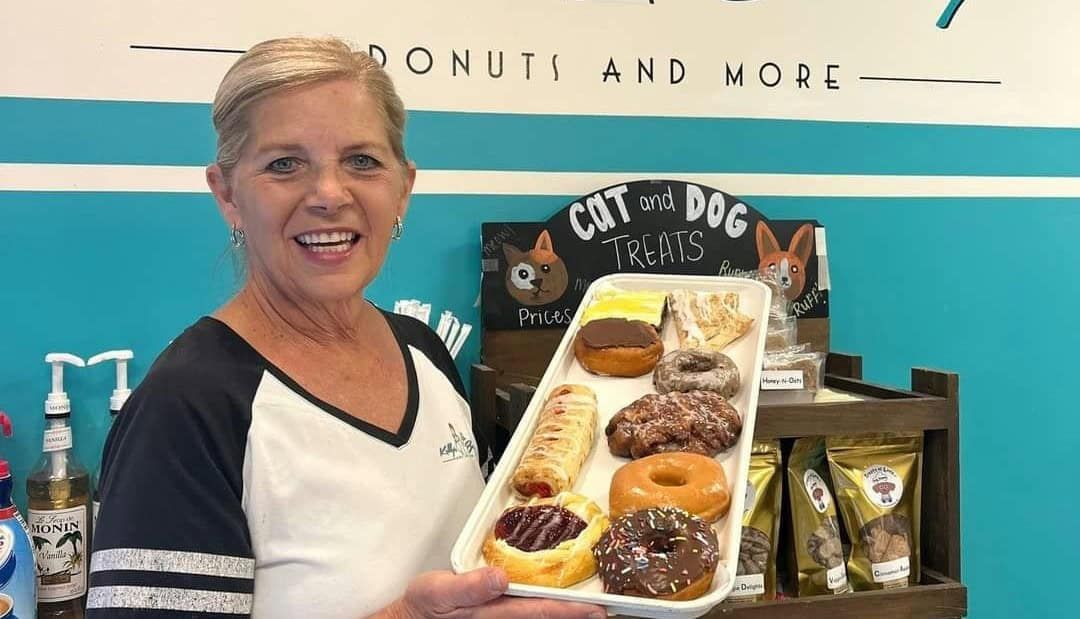Emergency and Trauma Care
Want to learn more about this at Kettering Health?
Diana Ramsey had just arrived home from a morning at her bakery, still covered in sugar, flour, and glaze. Then a sharp, searing pain shot through her abdomen.
She tried to lie down, thinking it would pass. But the pain only intensified when she stretched out. Panic set in. She called out to her husband, Charlie, who ran inside from the front yard to find Diana clammy and doubled over.
“I consider myself as someone with a pretty high pain tolerance,” Diana says. “But, this was a level of pain I’d never experienced before, and it was getting worse with each passing second.”
The pain pushed Diana to the edge of consciousness and showed no signs of stopping.
“My husband looked at me and said, ‘We need to get to the emergency room now.’”
They took off for Kettering Health Hamilton before Diana could even change out of her work clothes, or as she calls them, her “donut gear.”
A bakery is born
For Diana, baking runs in the family. Her sister, Teri, owns and operates a popular shop in Fairfield called, The Donut Spot.
“We grew up baking,” Diana says. “Especially around Christmas time. We would bake dozens of cookies and pass them out to friends and family.”
Diana returned to baking after a career in sales left her burnt out and looking for something new.
“My sister didn’t want to open a second bakery, but she said she’d help me start my own.”
In 2014, Diana opened Kelly’s Bakery—named after her daughter—on the westside of Hamilton. Within the shop’s white and blue walls, customers stop in on their way to work or school. Others grab a chair and stay a while. Either way, Diana is always happy to see them, and they’re always happy to see her.
“We’re not one of those businesses that has to deal with unhappy customers,” she says. “It’s hard to be upset when you’re eating a donut.”
Days in the bakery are fast-paced. Diana scrambles to fill orders, make deliveries, and restock ingredients. So, when her abdomen felt like it had burst, bringing her to a stop, she and Charlie knew they needed to move quickly.
A new normal
Within minutes of arriving at Kettering Health Hamilton’s emergency department, Diana was in a patient room for assessment and imaging. A CAT scan revealed that her colon had ruptured, known as a gastrointestinal perforation. To make matters worse, she had gone septic.
“The pain was so bad that I was almost comatose at that point,” she says. “When the nurses asked me what my pain level was on a scale of 1 to 10, I could only murmur that it was a 10.”
Other injuries that often clock in at a 10 include crushed bones and severed limbs.
Diana was rushed into emergency colostomy surgery to reconstruct her digestive tract to accommodate the rupture. She came out with a six-inch incision down her stomach–and a colostomy bag.
These bags collect stool when the body can’t expel waste naturally. Instead of passing through the bowels and out the rectum, waste is re-routed through the abdomen and into the bag.
“It was shocking to say the least,” Diana says. “Waking up with the realization that your body looks and functions drastically different than before is a lot to take in.”
During the eight days she spent recovering in the hospital, Diana’s care team taught her how to change out the bag and wear it properly.
Diana had concerns about what others would think, but she was relieved to find it wasn’t as bad—or gross—as she feared. When Diana returned to work at the bakery, most people didn’t even know she was wearing the bag.
“A colostomy bag is a huge adjustment, but it isn’t the end of the world,” she says. “You can still live your life.”
After six months, Diana recovered enough to undergo a reverse colostomy to restore the normal functioning of her digestive tract. If it went well, she’d no longer need the colostomy bag.
Betting on compassionate care
Not every reverse colostomy is successful. Sometimes they can lead to permanent damage and further risks of infection.
“A lot of people told me not to get the reversal because it can be risky,” Diana says. “I did it anyway because I trusted the surgical team at Kettering Health. I felt confident that I’d have a good outcome.”
And she was right.
Diana returned to her bakery less than four weeks after the reversal surgery.
She still gets choked up when she thinks about how different her life could have been. Thirty percent of people with a ruptured colon don’t survive. That rate increases when the person goes septic.
“It’s rare to fully recover after something like this,” she says. “I credit that to my care team.”
Now, when Diana arrives at Kelly’s Bakery, long before the sun rises and droves of customers file in, she reflects with a renewed sense of gratitude on how life isn’t all sprinkles and frosting. But, when the scent of freshly baked donuts and the hum of happy customers fills her bakery—it seems to be.










